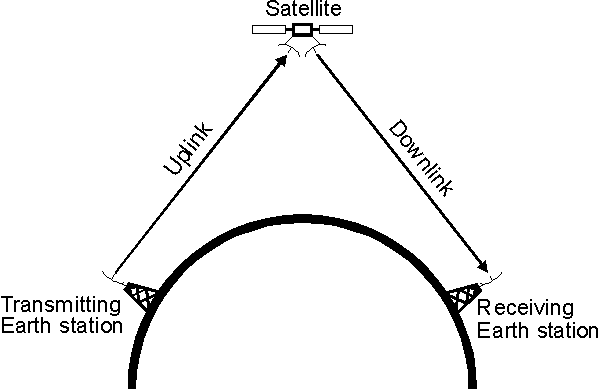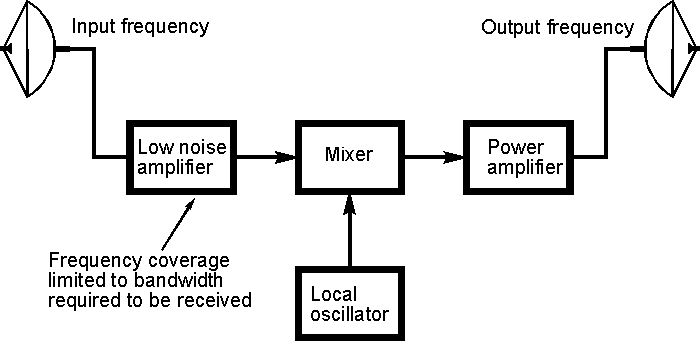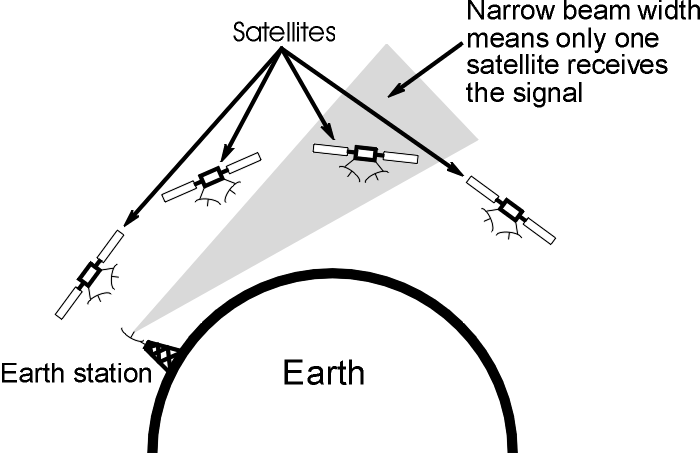Satellite communications basics
- an overview, tutorial and information about the basics of satellite
communications
Satellites are able fulfil a number of roles. One of the
major roles is for satellite communications. Here the satellite enables
communications to be established over large distances - well beyond the line of
sight. Communications satellites may be used for many applications including
relaying telephone calls, providing communications to remote areas of the Earth,
providing satellite communications to ships, aircraft and other mobile vehicles,
and there are many more ways in which communications satellites can be used.
Satellite communications basics
When used for communications, a satellite acts as a repeater.
Its height above the Earth means that signals can be transmitted over distances
that are very much greater than the line of sight. An earth station transmits
the signal up to the satellite. This is called the up-link and is transmitted on
one frequency. The satellite receives the signal and retransmits it on what is
termed the down link which is on another frequency.

Using a satellite for long distance communications
The circuitry in the satellite that acts as the receiver,
frequency changer, and transmitter is called a transponder. This basically
consists of a low noise amplifier, a frequency changer consisting a mixer and
local oscillator, and then a high power amplifier. The filter on the input is
used to make sure that any out of band signals such as the transponder output
are reduced to acceptable levels so that the amplifier is not overloaded.
Similarly the output from the amplifiers is filtered to make sure that spurious
signals are reduced to acceptable levels. Figures used in here are the same as
those mentioned earlier, and are only given as an example. The signal is
received and amplified to a suitable level. It is then applied to the mixer to
change the frequency in the same way that occurs in a superheterodyne radio
receiver. As a result the communications satellite receives in one band of
frequencies and transmits in another.
In view of the fact that the receiver and transmitter are
operating at the same time and in close proximity, care has to be taken in the
design of the satellite that the transmitter does not interfere with the
receiver. This might result from spurious signals arising from the transmitter,
or the receiver may become de-sensitised by the strong signal being received
from the transmitter. The filters already mentioned are used to reduce these
effects.

Block diagram of a basic transponder
Signals transmitted to satellites usually consist of a large
number of signals multiplexed onto a main transmission. In this way one
transmission from the ground can carry a large number of telephone circuits or
even a number of television signals. This approach is operationally far more
effective than having a large number of individual transmitters.
Obviously one satellite will be unable to carry all the
traffic across the Atlantic. Further capacity can be achieved using several
satellites on different bands, or by physically separating them apart from one
another. In this way the beamwidth of the antenna can be used to distinguish
between different satellites. Normally antennas with very high gains are used,
and these have very narrow beamwidths, allowing satellites to be separated by
just a few degrees.

Separating satellites by position
Direct broadcast communications satellites
Another variant of communications satellites is those used
for direct broadcasting. This form of broadcasting has become very popular as it
provides very high levels of bandwidth because of the high frequencies used.
This means that large numbers of channels can be carried. It also enables large
areas of the globe to be covered by one delivery system. For terrestrial
broadcasting a large number of high power transmitters are required that are
located around the country. Even then coverage may not be good in outlying
areas.
These DBS satellites are very similar to ordinary
communications satellites in concept. Naturally they require high levels of
transmitted power because domestic users do not want very large antennas on
their houses to be able to receive the signals. This means that very large
arrays of solar cells are required along with large batteries to support the
broadcasting in periods of darkness. They also have a number of antenna systems
accurately directing the transmitted power to the required areas. Different
antennas on the same satellite may have totally different footprints.
Satellites for mobile phones
Satellites have also been used for cellular style
communications. They have not been nearly as successful as initially anticipated
because of the enormously rapid growth of terrestrial cellular
telecommunications, and its spread into far more countries and areas than
predicted when the ideas for satellite personal communications was originally
envisaged. The systems that were set up used low earth orbiting satellites,
typically with a constellation of around 66 satellites. Handheld phones then
communicated directly with the satellites which would then process and relay the
signals as required.
The main advantage of the satellite system is that it is
truly global and communications can be made from ships, in remote locations
where there would be no possibility of there being a communications network.
However against this the network is expensive to run because of the cost of
building and maintaining the satellite network, as well as the more
sophisticated and higher power handsets required to operate with the satellite.
As a result these networks have not been financially successful.
Satellite communications summary
Although the basics of satellite communications are fairly
straightforward, there is a huge investment required in building the satellite
and launching it into orbit. Nevertheless many communications satellites exist n
orbit around the globe
|

